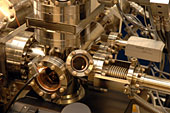AMES, Iowa - Andrew Hillier turned on the computers and started showing off what Iowa State University's new lab can do.
The star of the nanoshow was Iowa State's new Local Electrode Atom Probe microscope, an instrument that can gather data and produce images at the atomic scale of billionths of a meter. Iowa State purchased the instrument with the help of a $1.6 million grant from the W.M. Keck Foundation.
Look at this, said Hillier, an Iowa State associate professor of chemical and biological engineering, as he rotated a 3-D image representing millions of atoms. The image was made up of tiny green, red and orange dots. Each dot represented an atom. And each color represented an element.
Light green, for example, was nickel.
And thanks to the light green dots, you could clearly see a line of nickel atoms running through the metal alloy.
Is that a defect in the alloy? Hillier wondered. Some kind of weak spot? Or a characteristic of this particular mixture of elements?
Those are the kinds of questions the researchers who will use the W.M. Keck Laboratory for High Throughput Atom-Scale Analysis will try to answer. Their answers could lead to the discovery of advanced metal alloys for the aerospace industry, new catalysts for chemical synthesis, new materials to power fuel cells and new technologies for delivering drugs.
"This laboratory is really unique and provides information that you can't get any other way," Hillier said. "It's hard to overestimate what this lab can do."
Iowa State will dedicate the new laboratory at 2 p.m. Wednesday, May 30, with a ceremony in the Alliant Energy-Lee Liu Auditorium in Howe Hall. The program will be followed by a reception and tours of the lab in Room 3022 of Sweeney Hall.
Iowa State researchers will also show off the new lab during a full-day symposium on campus that will explore "Atom Probe Tomography: Opportunities and Challenges for New Materials Science." The symposium is part of the National Science Foundation's International Materials Institute for Combinatorial Sciences and Materials Informatics Collaboratory. The symposium will bring top experts in materials science to campus to see the atom probe microscope and how Iowa State researchers are using it with other powerful tools such as the IBM Blue Gene/L supercomputer and the C6 virtual reality laboratory.
The researchers leading the lab are Hillier, Balaji Narasimhan, a professor of chemical and biological engineering and director of Iowa State's Institute for Combinatorial Discovery; Krishna Rajan, the director of the international combinatorial sciences and materials informatics collaboratory, Stanley Chair in Interdisciplinary Engineering and a professor of materials science and engineering; and Sriram Sundararajan, an assistant professor of mechanical engineering.
Iowa State's atom probe microscope -- one of four at U.S. universities -- works by creating an electrical field that peels one atom at a time from a needle-shaped sample and then uses mass spectrometry technology to detect and record the location and type of each atom. It's a powerful tool, but it's hardly the only one in the lab.
Hillier said the laboratory also has tools -- including a chemical printer and a combinatorial sputtering system -- that allow researchers to prepare large numbers of material samples for testing and analysis. There are also tools -- including an infrared microscope, an electrochemical microscope and an atomic force microscope -- that allow researchers to study and understand the performance of various material samples.
All those tools will advance Iowa State's work in combinatorial science, the rapid screening, testing and invention of new materials. The idea is to rapidly analyze thousands of material samples in hours or days, rather than the weeks or years it can take to analyze one sample at a time. Iowa State researchers are focusing their efforts on developing new catalysts, biomaterials and nanomaterials.
The lab's tools can be applied to a wide variety of those projects:
- Hillier is trying to find an inexpensive catalyst that could replace platinum and its high costs in a low-temperature hydrogen fuel cell.
- Narasimhan is studying how biomaterials chemistry could be used to switch on and balance the two arms of the human immune response.
- Rajan is studying atomic scale chemical clustering in materials to help develop the atom probe microscope as a tool for the direct visualization of crystal structure.
- Sundararajan, together with collaborators in materials science and mechanical engineering, is developing heat-resistant, low-friction coatings for the tools the aerospace industry uses to machine titanium.
Narasimhan said the lab will also advance the work of the 35 faculty from 12 academic departments and four colleges who are part of Iowa State's Institute for Combinatorial Discovery. He said the lab also complements the materials science work at the U.S. Department of Energy's Ames Laboratory on the Iowa State campus.
Rajan said the atom probe microscope is one of the reasons he accepted a faculty position at Iowa State. He sees tremendous potential for using it in collaboration with researchers who work with Iowa State's supercomputing and virtual reality facilities.
Sundararajan said the lab will impact the kind of research proposals produced at Iowa State.
"What this lab and these kinds of instruments allow us to do is think on a larger scale for our research proposals," he said. "We will be able to pursue unique problems and projects. The laboratory will be the catalyst for a lot of interdisciplinary research proposals that will go out from Iowa State."
The lab, said Narasimhan, the author of a book to be published in July called "Combinatorial Materials Science" will allow Iowa State to "really take on a leadership role in combinatorial discovery."
